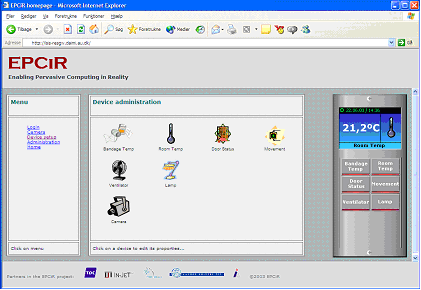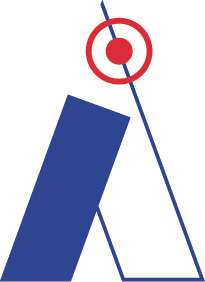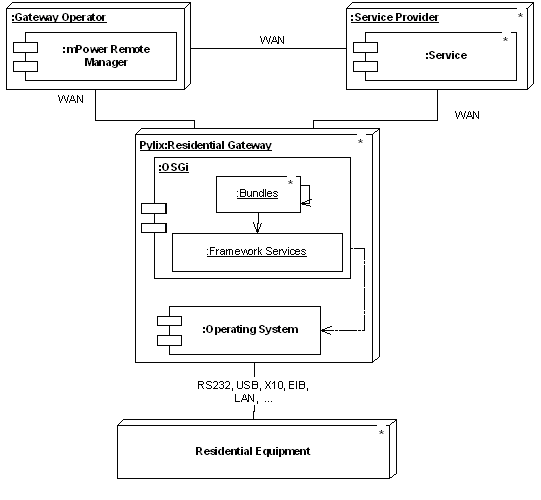Navigation
Share this Subscribe to our mailing listArticles Hierarchy
EPCiR
| EPCiR Enabling Pervasive Computing in Reality |
National project Finished 2003 |
|
|
The EPCiR project (Enabling Pervasive Computing in Reality) was a 6-months national project funded by the ISIS Katrinebjerg organisation, a joint undertaking between the Municipality of Aarhus, the University of Aarhus and a group of industrial companies. The purpose of was to investigate and evaluate technical platforms and protocols for pervasive computing and to establish a platform for further research and innovation projects. Rationale The realization of the vision of “pervasive computing” raises a number of technical and application related issues: How should the infrastructure (hardware, software, network) of such a system be built, what are the security aspects and implications and what are they implications of this in terms of user acceptance? There are already a number of platforms with suggestions on how pervasive computing technology shall be realized, but not a comprehensive analysis of the usefulness of such systems. The EPCiR project aims to investigate and evaluate the existing technical platforms and protocols for pervasive computing and establish a platform for further research and development projects. Architecture The architecture of an IT system is the system's overall structure - hardware and software - in the form of components and connections between them. As such, the architecture represents the highest level of design of IT systems, why it is essential that the design of this level is appropriate. The ICT architecture for future applications based on a pervasive computing platform is not well defined, and there is a need for an architectural analysis that takes openness into account. A variant of Quality Attribute Workshops was used in EPCiR to establish requirements for the architecture based on architectural qualities. From the analysis, a suitable pervasive computing platform architecture was identified as shown in Figure 1.
Figure 1 Part of the analysed architecture
The main components of the architecture are:
Technical features The primary criteria for selection of components in the pervasive computing architecture are accessibility and usability criteria. The criteria include interaction, functionality, flexibility and security, which again points to having a generic device that collect data from the heterogeneous devices and communicate these data to the outside world. This construct is normally referred to as a (residential) gateway. Furthermore, with a view to the needs for of flexibility, the use of a standardized software platform on top of the gateways was decided. The Open Services Gateway Initiative (OSGi) defines such standard. A prototype of the pervasive computing infrastructure was developed for the home automation domain. The user interface is shown in Figure 2.  Figure 2 User interface for a home automation application running on a OSGi gateway.
Finally, the project evaluated the technology in terms of business potential. The starting point for the business analysis was buildings and data communication between buildings and the outside world. The conclusion was that there are some external environmental factors, which in future will change the business systems into much more complex entities than we know today. At the same time they will deliver more value and content for both the home and the business markets. In conclusion, the project recommended the use of a residential gateway to collect data from heterogeneous devices in the home or building based on the OSGi framework. A security analysis pointed to the need for more security research into security in distributed systems. On the basis of defined external factors and value drivers, the EPCiR project shows that sustainable business cases can not be built without a business models that involve the Value Nets concept, i.e. values for customers arises largely when the service offered consists of several complementary service from different providers. Project Outcomes The project delivered knowledge of pervasive computing platforms from three perspectives: usage, infrastructure and security. Also an assessment of the business potential of such platforms was undertaken. The platform was further developed in the eu-DOMAIN project. |
||
In-JeT’s role in the project In-JeT was the chief vision-owner of the Hydra project. As manager of the workpackage on requirements engineering, we undertook scenario thinking workshops and developed future scenarios for usage of the Hydra middleware by developers. We further managed the iterative requirement process and developed procedures for capturing Lessons Learned and performed requirements re-engineering, constantly keeping the project aligned with its objectives and vision. In-JeT was also in charge of the workpackage on business modelling, where we, together with partners, developed concepts and methods for value models and process models and created business cases in the domains of healthcare, energy control and agriculture. On the dissemination and exploitation side, we developed the projects’ dissemination strategy and the Hydra website. Finally In-JeT also chaired the Technical Advisory Board. |
||
Partners TDC Totalløsninger A/S, Denmark (Coordinator) Innovation Lab Katrinebjerg, Denmark In-JeT ApS, Denmark ISIS Katrinebjerg, Denmark Center for It-Sikkerhed, Alexandra Instituttet (AICIS), Denmark University of Aarhus, Dept. of Computer Science, Denmark |
||
| Funding Co-funded by ISIS Katrinebjerg, Denmark http://isis.alexandra.dk/ Project budget: 912 kDkr. Project funding: 532 kDkr. Project start date: 1 May 2003 Project end date: 30 September 2003 |
 |
|
|
|
||




